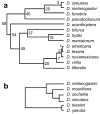Evolutionary conservation of lampbrush-like loops in drosophilids
- PMID: 17697358
- PMCID: PMC1978495
- DOI: 10.1186/1471-2121-8-35
Evolutionary conservation of lampbrush-like loops in drosophilids
Abstract
Background: Loopin-1 is an abundant, male germ line specific protein of Drosophila melanogaster. The polyclonal antibody T53-F1 specifically recognizes Loopin-1 and enables its visualization on the Y-chromosome lampbrush-like loop named kl-3 during primary spermatocyte development, as well as on sperm tails. In order to test lampbrush-like loop evolutionary conservation, extensive phase-contrast microscopy and immunostaining with T53-F1 antibody was performed in other drosophilids scattered along their genealogical tree.
Results: In the male germ line of all species tested there are cells showing giant nuclei and intranuclear structures similar to those of Drosophila melanogaster primary spermatocytes. Moreover, the antibody T53-F1 recognizes intranuclear structures in primary spermatocytes of all drosophilids analyzed. Interestingly, the extent and conformation of the staining pattern is species-specific. In addition, the intense staining of sperm tails in all species suggests that the terminal localization of Loopin-1 and its orthologues is conserved. A comparison of these cytological data and the data coming from the literature about sperm length, amount of sperm tail entering the egg during fertilization, shape and extent of both loops and primary spermatocyte nuclei, seems to exclude direct relationships among these parameters.
Conclusion: Taken together, the data reported strongly suggest that lampbrush-like loops are a conserved feature of primary spermatocyte nuclei in many, if not all, drosophilids. Moreover, the conserved pattern of the T53-F1 immunostaining indicates that a Loopin-1-like protein is present in all the species analyzed, whose localization on lampbrush-like loops and sperm tails during spermatogenesis is evolutionary conserved.
Figures


Similar articles
-
Drosophila melanogaster kl-3 and kl-5 Y-loops harbor triple-stranded nucleic acids.J Cell Sci. 2008 May 15;121(Pt 10):1605-12. doi: 10.1242/jcs.025320. Epub 2008 Apr 22. J Cell Sci. 2008. PMID: 18430782
-
Y chromosome loops in Drosophila melanogaster.Genetics. 1988 Dec;120(4):1015-34. doi: 10.1093/genetics/120.4.1015. Genetics. 1988. PMID: 2465201 Free PMC article.
-
The kl-3 loop of the Y chromosome of Drosophila melanogaster binds a tektin-like protein.Genetics. 1993 Mar;133(3):569-79. doi: 10.1093/genetics/133.3.569. Genetics. 1993. PMID: 8454204 Free PMC article.
-
Spermatogenesis in Drosophila.Int J Dev Biol. 1996 Feb;40(1):167-76. Int J Dev Biol. 1996. PMID: 8735926 Review.
-
Y chromosomal fertility genes of Drosophila: a new type of eukaryotic genes.Genome. 1989;31(2):561-71. doi: 10.1139/g89-105. Genome. 1989. PMID: 2561109 Review.
Cited by
-
Subcellular Specialization and Organelle Behavior in Germ Cells.Genetics. 2018 Jan;208(1):19-51. doi: 10.1534/genetics.117.300184. Genetics. 2018. PMID: 29301947 Free PMC article. Review.
-
Satellite DNA-containing gigantic introns in a unique gene expression program during Drosophila spermatogenesis.PLoS Genet. 2019 May 9;15(5):e1008028. doi: 10.1371/journal.pgen.1008028. eCollection 2019 May. PLoS Genet. 2019. PMID: 31071079 Free PMC article.
-
Autosomal mutations affecting Y chromosome loops in Drosophila melanogaster.BMC Genet. 2008 Apr 11;9:32. doi: 10.1186/1471-2156-9-32. BMC Genet. 2008. PMID: 18405358 Free PMC article.
-
Drosophila as a Model System for Studying of the Evolution and Functional Specialization of the Y Chromosome.Int J Mol Sci. 2022 Apr 10;23(8):4184. doi: 10.3390/ijms23084184. Int J Mol Sci. 2022. PMID: 35457001 Free PMC article. Review.
-
Functional Significance of Satellite DNAs: Insights From Drosophila.Front Cell Dev Biol. 2020 May 5;8:312. doi: 10.3389/fcell.2020.00312. eCollection 2020. Front Cell Dev Biol. 2020. PMID: 32432114 Free PMC article. Review.
References
-
- Cooper KW. Normal spermiogenesis in Drosophila. In: Demerec M, editor. Biology of Drosophila. New York and London, Hafner Publishing Company; 1965. pp. 1–61.
-
- Fuller MT. Genetic analysis of spermatogenesis in Drosophila: the role of the testis-specific β-tubulin and interacting genes in cellular morphogenesis. In: Gall JG, editor. Gametogenesis and the Early Embryo. New York, Alan R. Liss; 1986. pp. 19–42.
-
- Tates AD. PhD Thesis. Leiden University; 1971. Cytodifferentiation during spermatogenesis in Drosophila melanogaster.http://flybase.bio.indiana.edu/reports/FBrf0023103.html
-
- Lindsley DL, Tokuyasu KT. Spermatogenesis. In: Ashburner M, Wright TRF, editor. The Genetics and Biology of Drosophila. Vol. 2. New York, Academic Press; 1980. pp. 225–294.
MeSH terms
Substances
LinkOut - more resources
Full Text Sources
Molecular Biology Databases

